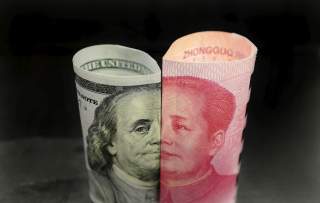China's Economy: Not So Big After All
New research suggests that China's economy is only half the size of America's—and growing much more slowly than officially reported.
China’s economy isn’t what it used to be (at least as recently as last week). Four intrepid economists—Wei Chen, Xilu Chen and Michael Song of the Chinese University of Hong Kong, along with Chang-Tai Hsieh of the University of Chicago—have taken a fine-toothed comb to Chinese economic data to try to tease out China's true rate of economic growth since 2008. Not surprisingly, they found that China has been over-reporting its growth rate by an average of 1.7 percentage points every year.
Shave off a little growth every year for the last dozen years ago, and the cumulative effect is that China is now overstating its true GDP by nearly 20 percent.
The four economists’ “forensic examination” of China’s GDP figures relied on hard-to-fake data like tax receipts, nighttime light intensity observed from satellites, electricity generation, railway cargo and merchandise exports to estimate China’s true growth rate since the 2008 Global Financial Crisis. Their estimates are both much more volatile and nearly always lower than the figures reported by China’s National Bureau of Statistics.
China’s 2018 GDP on China’s official statistical website shows that ¥93.15 trillion translates to around $13.4 trillion in U.S. dollars. That compares to $20.5 trillion for the United States, valuing China's economy at about 65 percent of the size of America's. Of course, China has more than four times the population of the United States, so in per capita terms China is still way behind at $9,800 compared to nearly $63,000 for the United States.
No one except the Western news media and the Communist Party of China ever believed those figures, but now we know they are fake. The four economists’ new figures, published Thursday in one of the Brookings Institution’s working papers, suggest that both GDP and GDP growth in China are far below what the headlines say. Assuming that China was accurately reporting its GDP figures back in 2008, the new estimate for 2018 would be $11.1 trillion, or only about 54 percent of the size of the American economy.
That implies a per capita figure of only around $8,000, well below Mexico’s figure of $9,600 and only about one-eighth of the U.S. level. And that's assuming that the 2008 baseline figures weren’t themselves over-inflated. Back in 2007, Li Keqiang (then a regional party boss but now the premier of China) famously called them “man-made.” And the lower the 2008 base number, the lower the imputed figure for today.
Taking China’s reported 2018 growth rate of 6.5 percent down by 1.7 points would give a current growth figure of only 4.8 percent, well below that of regional competitors like Vietnam and India (both at 7.3 percent). It also means that, even at current growth rates, China won’t catch up to the United States anytime soon. Extrapolating China at 4.8 percent and the United States at its historical average of 2.1 percent, China’s economy wouldn't surpass America’s until 2036, in per capita terms not until 2076. That’s a lot of extrapolation.
Historical data from other East Asian tiger economies suggest that things work turn out that way. The era of rapid economic growth in South Korea and Taiwan came to an end in the early 2000s, at a time when they were only about one-third as rich as the United States (in per capita terms). They have both spend the last two decades struggling to stay about half the American level of GDP per capita. Neither is as prosperous as the poorest U.S. state, Mississippi. Japan is only on a par with the second poorest, Alabama.
China has pockets of prosperity in Beijing, Shanghai and Guagzhou/Shenzhen that are approaching East Asian tiger levels, but most of the country is still very poor. The idea that China poses a serious economic (and thus military) challenge to the United States is simply preposterous. As its growth slows, it is rapidly becoming clear that the emperor has no clothes. Thanks to the detailed work of Chen, Chen, Hsieh and Song, we now have the hard evidence to prove it.
Salvatore Babones is the author of The New Authoritarianism: Trump, Populism, and the Tyranny of Experts.
Image: Reuters

